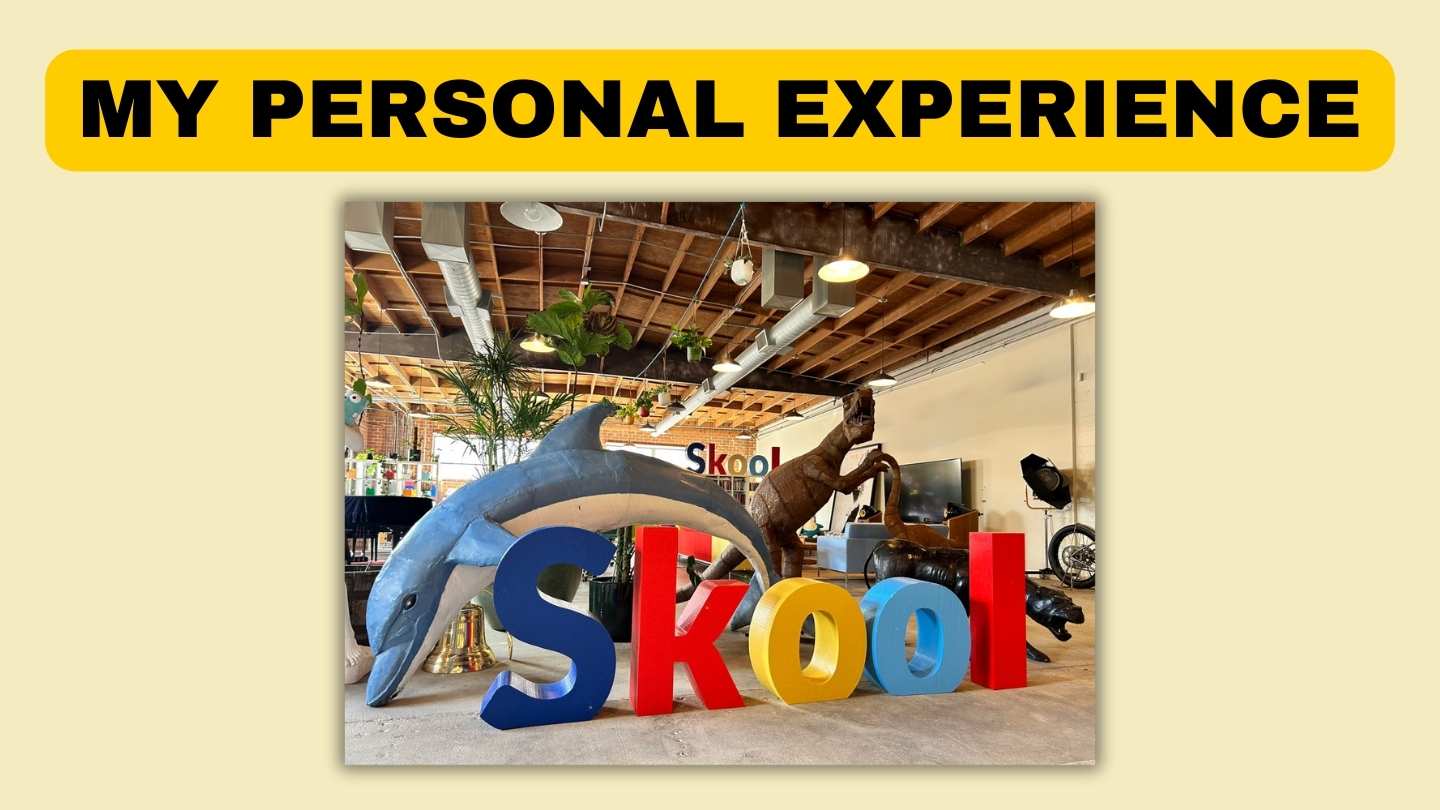Hey there, educator!
If you’ve ever felt overwhelmed trying to juggle YouTube videos, separate chat groups, and random documents just to teach your students, you’re not alone. I remember when I first started teaching online: I had lesson videos on one platform, PDFs on another, and student questions scattered all over my inbox. It felt messy and time-consuming.
Then I discovered the Skool community app. It brings everything—your lessons, discussions, and resources—together in one place, so you can focus on what really matters: helping your students learn and grow.
In this guide, I’ll walk you through:
- Exactly how to start your own Skool community
- Tons of practical examples, so you can picture what your community might look like
- How to get started with a FREE 14-day trial to test it out without risk
By the end, you’ll see how easy it is to create a thriving online learning space that feels structured, supportive, and fun.
Let’s dive in!
What Kind of Skool Education Community Should You Create?
Before jumping into building your Skool community, think about your teaching niche. The more specific and focused your community is, the easier it will be to attract the right learners.
Examples:
- If you’re an English tutor who focuses on conversational English, your Skool community could revolve around weekly speaking challenges, pronunciation tips, and short grammar lessons.
- If you teach coding for beginners, your community might include step-by-step tutorials, practice projects, and Q&A sessions to troubleshoot coding errors.
- If you’re helping adults learn a new skill—like photography—your community might share weekly photo prompts, tutorials on camera settings, editing tips, and a feedback corner where members critique each other’s images.
As you brainstorm, consider:
- Who are your learners? (High school students, busy professionals, hobbyists?)
- What do they struggle with? (Staying motivated, understanding difficult concepts, finding reliable resources?)
- What’s their ultimate goal? (Passing an exam, launching a new career, or simply enjoying a new hobby?)
Pro Tip: The clearer you are about your audience, the more relevant and helpful your community will feel to them.
Step 1: Understand Your Audience
Knowing your audience is crucial. Imagine you teach graphic design basics to total beginners who want to create simple logos and social media graphics.
How do you identify their needs?
- Experience Level: Are they starting from scratch, or do they already know a bit about design tools like Canva or Photoshop?
- Learning Style: Do they learn best from video demos, live workshops, or written guides?
- Time Commitment: Are they busy professionals who can only watch short, 10-minute tutorials a few times a week, or dedicated students who have hours each day?
Example: Let’s say your students are busy professionals who only have 15 minutes a day. That means you might create short, bite-sized lessons and a Q&A board where they can ask quick questions and get timely answers.
By understanding these details, you can shape your Skool community so it’s convenient, efficient, and valuable for them.
Step 2: Brainstorm Community Ideas
Once you know who you’re teaching, get creative with what your community can offer!
A Few Specific Ideas:
- The “Study Buddy” Group: If you teach math, create daily practice problems and encourage students to share their solutions. Offer a “Problem of the Week” challenge where everyone tries to solve a tricky puzzle, then discuss the solution together.
- Certification Prep Hub: If you help students prepare for an exam, like a language proficiency test (e.g., TOEFL) or a professional certificate, set up sections for sample tests, grammar drills, vocabulary flashcards, and live practice sessions.
- Skill-Building Workshop: If you teach a practical skill, such as painting, carving, or even playing a musical instrument, consider offering weekly “Assignments.” Post a video showing a new technique and ask students to upload photos or recordings of their work, then give constructive feedback.
Example: Suppose you’re teaching personal finance basics. Your community could have:
- A “Budgeting 101” section with short lessons on how to start a budget.
- A “Daily Savings Tip” thread where you post one actionable savings idea every day.
- A “Success Stories” corner for members to share how they saved their first $1,000.
The sky’s the limit. Think about what would be most useful and inspiring for your learners.
Step 3: Set Up Your Skool Community
Skool makes it simple to structure everything. Let’s break down a possible setup step-by-step:
- Create Sections for Content:
Imagine you teach digital marketing. You might have:- “Getting Started”: Short videos explaining the basics of marketing funnels.
- “Tools & Resources”: PDF guides, cheat sheets, and recommended software lists.
- “Student Forum”: A place where learners can ask questions, share results, and support each other.
- “Live Sessions”: A calendar or schedule for live Q&A calls or webinars.
- Add Interactive Features:
Use polls to ask your learners what they want next: “Should we do a lesson on Facebook Ads or Email Marketing Automation this week?”
Host a weekly “Office Hours” video call where students hop in to ask you questions live. - Make It Fun and Engaging:
Offer weekly or monthly challenges:- For language learners: A “Speak-Up” challenge where everyone posts a short audio clip practicing a new phrase.
- For coders: A “Bug Hunt” challenge where you share a snippet of code with an error and they have to find and fix it.
- For designers: A “Logo Remix” challenge where they improve or redesign a basic logo you provide.
Each of these activities encourages interaction, learning, and a sense of community.
Step 4: Spread the Word
Now that you’ve set up a fantastic community, you need to invite people into your Skool Community . Consider:
- Social Media Shout-Outs: Post a quick video or story on Instagram or TikTok introducing your community: “Hey everyone, I’ve just launched an online group where you can learn design basics and get your questions answered. Join us for free for 14 days!”
- Email Your List: If you have an email newsletter, send a friendly announcement with a direct link to your Skool community. Offer a bonus for early joiners, like a free mini-course or a private Q&A session.
- Collaborate with Other Experts: Partner with another educator to cross-promote. If you teach writing, maybe team up with a teacher who focuses on publishing e-books. Your learners might be interested in both topics!
Step 5: Keep Improving
Your community shouldn’t stay static. Evolve it based on feedback:
- Ask for Suggestions: Create a poll or a feedback form. For example, “What topic do you want next? More lesson breakdowns, extra quizzes, or guest expert interviews?”
- Bring in Guest Speakers: If you teach entrepreneurship, invite a successful founder to do a live Q&A. If you teach cooking, bring in a guest chef to share a secret recipe.
- Celebrate Achievements: Did a learner complete their first project, pass an exam, or reach a milestone? Congratulate them publicly. Success stories inspire others to keep going.
Example: Suppose one of your members finally passes their professional exam after following your community’s study routines. Post a celebratory message: “Congrats to Sarah for acing her exam! Let’s all congratulate her on this huge win!” This recognition makes members feel valued and encourages them to stay engaged.
How Much Does It Cost?
Great news: You can start for free! Skool offers a 14-day free trial so you can test drive the platform. See how it feels to manage your community, upload lessons, host discussions, and run events. After that, the pricing is fair and flexible, so you can choose a plan that fits your growing needs.
Example Scenario:
- Start your free trial and invite a small group of learners—maybe 10 or 20 people.
- Gather feedback during the trial period.
- If everyone loves it and you see your community thriving, you can then decide if you want to keep going with a paid plan.
Conclusion
Creating a Skool community is like setting up your own virtual classroom—one that’s fun, interactive, and deeply supportive. No more hopping between different apps and platforms. Now, you can offer a seamless learning experience that keeps your students engaged and excited to show up.
Just follow these steps:
- Understand who you’re teaching and what they need.
- Brainstorm ideas that make sense for your learners.
- Organize your content and interactions in Skool’s easy-to-use interface.
- Spread the word and get people excited to join.
- Keep making improvements as your community grows.
Remember, you have a 14-day free trial waiting for you, so there’s no risk. Give it a go, see how your students respond, and tweak the experience until it’s just right.
👉 Ready to get started? Click here to start your 14-day free trial and bring your teaching vision to life!
Let’s build a community where everyone feels supported, motivated, and eager to learn. You’ve got this!



